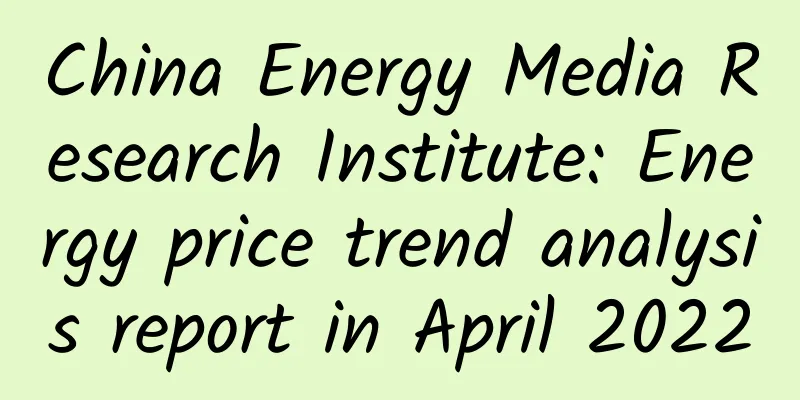China Energy Media Research Institute: Energy price trend analysis report in April 2022

|
Core Tips 1. International crude oil market In April, factors such as geopolitical tensions, intensified sanctions against Russia by Europe and the United States, Saudi Arabia raising the official price of crude oil, the severe epidemic in China causing concerns about demand, the IEA's plan to release oil reserves at a record level, the shutdown of Libya's largest oil field, the lower-than-expected increase in US crude oil inventories, and the IMF's downward revision of global economic growth expectations caused oil prices to fluctuate at a high level. As of April 29, WTI and Brent crude oil futures prices closed at US$104.69/barrel and US$109.34/barrel, respectively, up 64.66% and 63.78% year-on-year. 2. International natural gas market In April, the growth in residential and commercial gas demand, record export volumes, and inventories far below the five-year average jointly pushed US natural gas prices to their highest level in nearly 14 years. In contrast, as the temperature gradually warmed up, residential gas demand continued to decline, and natural gas prices in Europe and Asia showed an overall downward trend. As of April 29, the main contract of Henry Hub natural gas in the United States closed at US$7.24/MMBtu, up 147.10% year-on-year; the main contract of TTF in the Netherlands closed at 99.450 euros/MWh, down 21.01% from the previous month and up 327.10% from the previous year; Platts Japan-Korea LNG (JKM) futures price closed at US$24.53/MMBtu, down 30.77% from the previous month and up 175.93% from the previous year. 3. International coal market In April, the EU decided to ban Russian coal imports. Australia's main coal producing areas were restricted in exports due to rainfall and the epidemic. South Africa's export growth was also limited due to railway capacity restrictions. The international coal market supply tensions intensified, and coal prices in the three European ports, South Africa, and Australia rose again. As of April 29, the coal futures prices of Newcastle Port, Richards Port in South Africa, and the three European ports closed at US$326.60/ton, US$294.60/ton, and US$319.25/ton, respectively, up 250.05%, 215.92%, and 344.95% year-on-year, respectively. 1. Crude Oil Market 1. International crude oil supply competition intensified, and oil prices fluctuated at high levels International crude oil prices fluctuated at high levels in April. In early April, due to the tense geopolitical situation and the intensified sanctions against Russia by Europe and the United States, the uncertainty of crude oil supply increased. In addition, Saudi Arabia raised the official selling price of crude oil, and international oil prices rebounded slightly. Subsequently, affected by factors such as the IEA's plan to release a record 120 million barrels of oil reserves, international oil prices fell sharply under pressure. On April 11, WTI and Brent crude oil futures closed at US$94.29 per barrel and US$98.48 per barrel, respectively, falling to a six-week low. In late April, the shutdown of Libya's largest oil field, the EU's plan to impose an oil import ban on Russia, and the much lower-than-expected increase in US crude oil inventories exacerbated market concerns about global crude oil supply. International oil prices rose, but the IMF's downward revision of global economic growth expectations and the Fed's expectations of interest rate hikes limited the rise in oil prices. The average price of Brent futures in April was $105.92 per barrel, down 5.82% from the previous month. The average price of Brent futures since 2022 was $99.81 per barrel, up 40.68% from the average in 2021. As of April 29, WTI and Brent crude oil futures prices closed at $104.69 per barrel and $109.34 per barrel, respectively, up 64.66% and 63.78% from $63.58 per barrel and $66.76 per barrel in the same period of 2021. The U.S. Energy Information Administration's inventory report showed that as of April 29, U.S. crude oil inventories increased by 1.303 million barrels to 415.73 million barrels, compared with a previous estimate of a decrease of 829,000 barrels; crude oil inventories in the Cushing area increased by 1.379 million barrels to 28.829 million barrels; gasoline inventories decreased by 2.23 million barrels to 228.58 million barrels, compared with a previous estimate of a decrease of 589,000 barrels. Figure 1 Price trends of WTI and Brent crude oil in April 2022 The latest monthly crude oil market report released by the IEA shows that in terms of supply, in April, due to the closure of nearly 1 million barrels per day of Russian crude oil production, global crude oil supply decreased by 710,000 barrels per day to 98.1 million barrels per day. As sanctions against Russia intensify, Russia's supply will decrease by 1.6 million barrels per day and 2 million barrels per day in May and June respectively. It is expected that from July, Russia's crude oil supply losses may expand to about 3 million barrels per day. Although Russian supply disruptions are expected to intensify, the IEA does not expect a serious shortage of crude oil supply. Crude oil production from the Middle East, OPEC and the United States has risen steadily, and production in the rest of the world will increase by 3.1 million barrels per day from May to December. In terms of inventory, the IEA said that global oil inventories have fallen for seven consecutive quarters, with global observed oil inventories falling by 45 million barrels in March and a decrease of 1.2 billion barrels since June 2020. OECD oil inventories were 2.626 billion barrels in March, but still 299 million barrels below the five-year average. Preliminary data showed that OECD industrial inventories increased by 5.3 million barrels in April. In terms of demand, under the combined influence of the epidemic blockade and weak economic growth, the IEA lowered the growth of crude oil demand in the second quarter of 2022 to 1.9 million barrels per day. From April to August, global crude oil demand will increase by 3.6 million barrels per day, and the growth rate of global crude oil demand will slow to 490,000 barrels per day in the second half of the year. The IEA predicts that global crude oil demand will increase by 1.8 million barrels in 2022, reaching an average of 99.4 million barrels per day. In comparison, the latest monthly oil market report released by OPEC pointed out that the global crude oil demand forecast for 2022 is 100.29 million barrels/day (down 210,000 barrels/day from 100.5 million barrels/day previously), and the global crude oil demand growth rate forecast for 2022 is 3.36 million barrels/day (previously 3.67 million barrels/day); the monthly report also lowered the forecast for non-OPEC crude oil production in 2022 by 300,000 barrels/day, and Russia's 2022 crude oil production forecast by 360,000 barrels/day. 2. Domestic crude oil production grew steadily and refined oil prices fell Crude oil production grew steadily, and imports turned from decline to increase. In April, 17 million tons of crude oil were produced, a year-on-year increase of 4.0%, 0.1 percentage point faster than the previous month, and the average daily output was 567,000 tons. 43.03 million tons of crude oil were imported, a year-on-year increase of 6.6%, and a decrease of 14.0% last month. From January to April, 68.19 million tons of crude oil were produced, a year-on-year increase of 4.3%. 170.89 million tons of crude oil were imported, a year-on-year decrease of 4.8%. In April, domestic refined oil prices showed a downward trend. In late April, the price of No. 95 gasoline fell by 926.6 yuan/ton month-on-month to 9,279.4 yuan/ton, a decrease of 9.08%; the price of No. 92 gasoline fell by 903.3 yuan/ton to 9,021.9 yuan/ton, a decrease of 9.10%; the price of diesel fell by 273.4 yuan/ton month-on-month to 8,518.5 yuan/ton, a decrease of 3.11%. Table 1 Changes in national oil market prices in late April 2022 (Data source: National Bureau of Statistics) 2. Natural Gas Market 1. International natural gas market demand is stable, with prices fluctuating In April, the overall price of natural gas in the United States showed an upward trend. Affected by factors such as rising global energy prices and increasing concerns about supply and demand imbalances, the price of natural gas in the United States has soared for several days. The intraday contract price once soared to US$8.05/MMBtu, breaking the highest level in nearly 14 years. In April, the overall supply of natural gas in the United States was at a high level, and the total natural gas production in the 48 states remained at around 940-950 billion cubic feet per day. On the demand side, affected by low temperatures and snowfall, the monthly increase in residential and commercial gas consumption was large, resulting in a high growth rate in demand. According to data from the U.S. Energy Information Administration, the average U.S. LNG export volume in April was 11.6 billion cubic feet per day, slightly lower than the historical peak set in March. It is expected that the average U.S. LNG export volume will be 12.1 billion cubic feet per day from May to August. As of the end of April, the total amount of natural gas stored in underground storage facilities in 48 states of the United States was 1.6 trillion cubic feet, and the inventory was 17% lower than the five-year average. The record export volume and low domestic inventory have jointly pushed up the price of natural gas in the United States. As of April 29, the main contract of the U.S. Henry Hub natural gas closed at US$7.24/MMBtu, up 147.10% from US$2.93/MMBtu at the end of April 2021. Figure 2. Price trend of natural gas at Henry Hub in the United States in April 2022 In April, the overall natural gas price in Europe showed a downward trend. In April, as the temperature gradually warmed up, the demand for residential gas continued to decline, and the high price also suppressed the demand for industrial gas. The scale of pipeline gas from Russia to Europe and the scale of LNG shipped from the United States to Europe remained stable. According to the data of the European Gas Infrastructure Information Platform (GIE), the overall gas storage in Europe has entered the gas injection stage. The stable supply of pipeline gas, the increase in imported LNG, and the weakening of seasonal demand have put pressure on the price of the main TTF contract to fall. On April 27, Gazprom announced that it would suspend the supply of natural gas to Poland and Bulgaria from that day. These two countries became the first European countries to be "stopped" after the release of the Russian "Ruble Settlement Order". Affected by this, the Dutch TTF natural gas price jumped 24% during the day to 125 euros/MWh, and the increase narrowed at the end of the day, closing at 107.425 euros/MWh. Subsequently, the news that some European buyers agreed to pay for natural gas in rubles put pressure on European natural gas prices to fall. As of April 29, the main TTF contract closed at 99.450 euros/MWh, up 327.10% from 23.285 euros/MWh at the end of April 2021. Figure 3. Dutch TTF natural gas price trend in April 2022 In April, natural gas prices in Asia showed a downward trend. Affected by factors such as weak demand for power generation due to mild climate, high overall inventory levels, downward natural gas prices in Europe, and the suppression of gas demand by the epidemic in China, LNG prices in Asia as a whole showed a steady decline. Although demand was weak, due to high gas prices in Europe, which is also a major LNG importing region, the spot landed price of LNG in Northeast Asia remained at a high level in previous years. As of April 29, the Platts Japan-Korea LNG (JKM) futures price closed at US$24.53/MMBtu, up 175.93% from US$8.89/MMBtu at the end of April 2021. Figure 4 Platts Japan-Korea LNG (JKM) price trend in April 2022 2. Domestic natural gas production remained stable, and imports fell further Natural gas production remained stable, and imports fell further. In April, 17.7 billion cubic meters of natural gas was produced, up 4.7% year-on-year, 1.6 percentage points slower than the previous month, and the average daily output was 590 million cubic meters. 8.09 million tons of natural gas were imported, down 20.3% year-on-year, 12.5 percentage points wider than March. From January to April, 74.7 billion cubic meters of natural gas was produced, up 6.2% year-on-year. 35.87 million tons of natural gas were imported, down 8.9% year-on-year. Domestic LNG and LPG prices fell slightly in April. In late April, LNG prices fell by 268.5 yuan/ton month-on-month to 7705.4 yuan/ton, a decrease of 3.37%; LPG prices fell by 290.9 yuan/ton month-on-month to 6078.9 yuan/ton, a decrease of 4.57%. Table 2 Changes in national natural gas market prices in late April 2022 (Data source: National Bureau of Statistics) 3. Coal Market (I) The international thermal coal market is in a tight supply and demand situation, and thermal coal prices are on the rise On April 8, the EU imposed a new round of sanctions on Russia, including a ban on all types of coal imports from Russia. This is the first time the EU has imposed sanctions on Russian energy since Russia launched a special military operation against Ukraine. 45% of the EU's annual coal imports come from Russia, with a total value of about 4 billion euros. After the EU decided to sanction Russian coal, the global thermal coal market supply and demand tensions intensified, and the thermal coal futures prices in three European ports rose accordingly. Affected by the EU's ban on Russian coal, buyers in Northeast Asia and Europe are actively seeking alternative supplies from other markets and increasing purchases of Australian and South African coal. In fact, since the beginning of this year, rainfall in Australia's main coal producing areas and the epidemic have led to labor shortages, and exports have been relatively limited; South Africa's domestic export growth is also relatively limited due to limited railway capacity. The tight supply in the international coal market and the continued release of coal demand in Europe, Japan, South Korea and other countries have jointly pushed South African and Australian coal prices to climb above US$300/ton again. As of April 29, the coal futures price at the Port of Newcastle, Australia, closed at US$326.60/ton, up 250.05% from US$93.30/ton at the end of April 2021; the coal futures price at the Port of Richards, South Africa, closed at US$294.60/ton, up 215.92% from US$93.25/ton at the end of April 2021; the coal futures price at the three European ports closed at US$319.25/ton, up 344.95% from US$71.75/ton at the end of April 2021. Figure 5 International coal futures price trend in April 2022 According to the Russian Federal Statistics Service, Russia's coal production in March was 37.1 million tons, down 2.9% year-on-year. From January to March, Russia's coal production was 108 million tons, up 0.3% year-on-year. According to data from the U.S. Energy Information Administration, in March, U.S. coal production was 50.692 million short tons (45.987 million tons), a slight decrease of 0.4% year-on-year and a month-on-month increase of 7.6%. From January to March 2022, U.S. coal production was 147 million short tons (134 million tons), an increase of 5.1% over the same period last year. According to data from the Indian Ministry of Coal, in April, India's total coal and lignite production was 70.6 million tons, down 30.7% from the previous month and up 28.96% from the previous year. Among them, lignite production was 4.02 million tons, up 28.38% from the previous year. From January to April, India's total coal production (including lignite) was 341 million tons, up 29.4 million tons year-on-year, up 9.4%. (II) Domestic coal production grew rapidly, and coal prices mainly fell Raw coal production grew rapidly, and imports turned from decline to increase. In April, 360 million tons of raw coal were produced, a year-on-year increase of 10.7%, a slowdown of 4.1 percentage points from the previous month, and the average daily output was 12.09 million tons. 23.55 million tons of imported coal, an increase of 8.4% year-on-year, a decrease of 39.6% last month. From January to April, 1.45 billion tons of raw coal were produced, a year-on-year increase of 10.5%. 75.41 million tons of imported coal, a year-on-year decrease of 16.2%. In April, the impact of the domestic epidemic continued to spread. Under the situation of economic weakness, industrial enterprises resumed work slowly, and industrial electricity demand was weak. In addition, the current climate is relatively suitable, residential electricity demand has entered the off-season, coal consumption demand is limited, and the tight supply and demand pattern of coal has been significantly alleviated. The state has vigorously guaranteed energy supply, and the national coal production has remained at an average daily level of more than 12 million tons, and market prices continue to operate under pressure. Although the locomotive accident on the Daqin Line in mid-April caused a brief rebound in the transaction price of coal ports, as the Daqin Railway resumed normal operation, the inventory of ports along the line has increased to varying degrees. Under the wide supply and demand pattern, the comprehensive price of coal around the Bohai Sea continued to fall. As of April 26, the inventory of the nine northern ports was 19.803 million tons, a year-on-year decrease of 2.94 million tons. The spot comprehensive price of 5,500 kcal thermal coal around the Bohai Sea is 879 yuan/ton, and the long-term comprehensive price is 720 yuan/ton. In order to reduce the cost of coal imports and encourage end users to increase their purchases of imported coal, the State Council Tariff Commission issued an announcement on April 26, implementing a provisional import tax rate of zero on all coal from May 1, 2022 to March 31, 2023. However, international coal prices have fluctuated at high levels since the beginning of this year, while domestic coal prices have been reasonably adjusted under the policy of ensuring supply and stabilizing prices. The situation where the landed price of imported coal is less advantageous or even higher than that of domestic coal has frequently occurred, which will basically offset the cost reduction brought about by the implementation of zero tariffs. If international coal prices continue to fluctuate upward, the price gap between domestic and foreign trade coal may continue to widen, and my country's imported coal market will operate steadily but weakly. In April, the domestic coal market price was mainly falling. In late April, the price of anthracite rose by 14.9 yuan/ton month-on-month to 1657.1 yuan/ton, an increase of 0.91%; the price of ordinary mixed coal (4500 kcal) fell by 303.9 yuan/ton month-on-month to 840.0 yuan/ton, a decrease of 26.57%; the price of Shanxi large mixed coal (5000 kcal) fell by 336.7 yuan/ton month-on-month to 970.0 yuan/ton, a decrease of 25.77%; the price of coking coal rose by 104.4 yuan/ton month-on-month to 3210.0 yuan/ton, an increase of 3.36%. Table 3 Changes in national coal market prices in late April 2022 (Source: WeChat public account "China Energy Media Research Institute" Author: Zhao Juntao) |
<<: Qualcomm's crisis and redemption: The era of mobile phone chip dominance will end
>>: Deciphering whose cheese was moved by LeTV's rapid rise during Singles' Day?
Recommend
How to safely exit multiple Activities on Android
When making Android Apps, almost every App has a ...
Product analysis, function analysis | Bilibili Live!
Editor's Note: Since its listing , Bilibili (...
Lithuanian officials urge citizens to throw away Chinese mobile phones
Lithuanian politicians have jumped out again to a...
Liu Run's 5-minute Business School Practice Edition Baidu Netdisk download
Liu Run's 5-minute business school practice L...
What to do when H-index catches up with age? | The Graveyard of Quantum Many-Body
Written by | Carlo Let's first popularize the...
How much is one hundred ounces of gold worth in ancient times? Much less than I thought
In costume TV dramas, the emperor would often rew...
Anxious Internet TV: Caught between internal and external troubles
Since 2017, we have not heard the voices of Intern...
Why do bleeding wounds heal on their own?
Author: Fei Dao Duan Yu You must have had the exp...
He is the first person in China's optical fiber industry. Your "WiFi freedom" cannot be separated from him! |Time Letter
Special Project of Beijing Science Center Origina...
Weibo Fans Advertising and Charging Standards!
1. Introduction to Fantong What is Fantong? To pu...
The love and hate of a pixel, the troubles between programmers and designers
I didn’t intend to stir up the so-called conflict...
Analysis of Xiaohongshu's e-commerce "Little Oasis" platform
Different from algorithm-driven interest e-commer...
What is the difference between pure HTML5 APP and native APP?
[[151272]] I have written some pure H5 apps. Alth...
Why are weather forecasts always wrong when modern science is so advanced?
Seeing that the weather forecast said there would...
6-month-old baby early education training course video full set (56 episodes) Baidu cloud download
6-month-old baby early childhood training course ...







![[Promotion Case] How was the campaign that brought about a net increase of 60,000 users in 6 days created?](/upload/images/67cc40acb90fb.webp)

